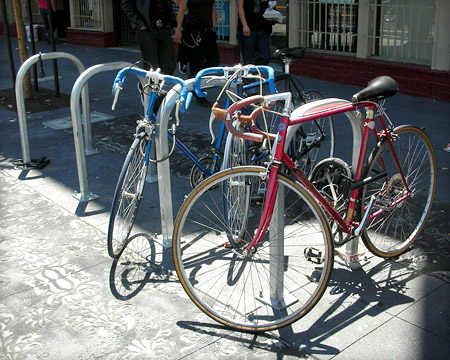See also Street Furniture Overview
See SFMTA Bicycle Parking homepage
Bicycle racks are an important element of the streetscape, both as an aesthetic aspect of the streetscape and as a functional element for those who travel by bike.
Despite the increasing numbers of San Franciscans choosing to travel by bicycle, many commercial districts, public transit stations and tourist attractions still lack adequate bicycle parking. Bicyclists need reasonable protection against theft. Bicycle parking is most effective when it is located close to trip destinations, is easy to find and is accessible.
Process Overview
SFMTA surveys, installs and maintains bicycle racks in the public-right-of-way unless they are in the jurisdiction of other City Departments such as Rec. and Park. Private racks are not allowed to be installed in the public right of way.
To request bicycle rack installation on the public right-of-way or to report a missing or loose rack, see SFMTA Bicycle Parking homepage. You will be asked note the address and cross street when making the request, as well as your contact information.
This service does not require a permit and is provided free of charge by the SFMTA.
See Permit Process
Official Codes & Documents
- Transportation Code requirements
(Section 909.1 of the San Francisco Transportation Code) - San Francisco Bicycle Plan
(Plan for guiding expansion of San Francisco’ bicycle facilities) - Better Streets Plan (street design guidelines)
- SFMTA Bicycle Rack Placement Guidelines
Design Guidelines
Street Types: Downtown commercial, Commercial throughway, Neighborhood commercial, Downtown residential, Residential throughway, Neighborhood residential, Industrial, Mixed-use, Parkway, Park edge, Multi-way boulevard, Ceremonial, Alley, Shared public way, Paseo
Sidewalk Zones: Extension Zone, Furnishing Zone
Location of bicycle racks
Bicycle racks should conform to SFMTA’s bicycle rack placement criteria.
Bicycle racks should be located according to the following guidelines:
- There must be at least a six-foot clear walkway, to comply with the Americans with Disabilities Act. This does not include frontage occupied by street furniture.
- Bicycle racks should be frequent in active commercial districts. Racks should be provided near major destinations such as schools, libraries, transit stops, major shopping and service destinations, and other locations with high pedestrian traffic.
- Where parking meter consolidation programs are implemented, bike racks should be provided to replace meter poles, or meter poles should be retrofitted with rings to allow bike parking.
- Racks should be located in either the furnishings zone or on curb extensions where possible. Racks should not be placed at accessible parking (blue curb zones) or passenger loading zones.
- At transit stops, bike racks should be placed near the back of the transit stop, further from the shelter (where present), or be placed outside of but adjacent to the transit stop. Bike-sharing pods, where provided, should be placed outside of but adjacent to the transit stop.
- Placement and spacing of bicycle racks should consider dimensions when occupied.
- Bike racks placed in the furnishings zone should be perpendicular to the curb where sidewalks are wide enough so that bikes parked at them do not project into the throughway or edge zone. Where this space is not available, bike racks should be placed parallel to the curb. Perpendicular bike racks should be placed at either edge of a tree basin, a minimum of 2 feet from the edge to allow a person to easily pull their bike in and out.
- A rack should be at least 2 feet from the curb, with 3 feet preferred.
- Bicycle racks should not be located directly in front of a store/building entrance or exit or in a driveway.
- There should be at least 3 feet of clearance between bicycles parked at racks and any other street furniture, with the exception of other bike racks, which should be placed a minimum of every 3 feet on center.
- Bicycles parked at a rack should have a minimum 1 foot clearance from utility vaults.
On-street bike parking: Where sufficient demand exists or where sidewalk space is constrained, replacing an on-street vehicle parking space with bicycle parking should be considered.
See Bike Corrals (On-Street Bike Parking).
Design of bicycle racks
The inverted “U” rail rack is the preferred rack for normal sidewalk installation. A bike rack should be sturdily attached to the ground to prevent theft.
Galvanized or stainless steel materials that are not powder-coated are more secure and are easier to maintain; where there is a specialized streetscape palette with particular design scheme, bicycle racks should be considered that match other site furnishings.
All elements of a bike rack should have a minimum 2 inch diameter (or 2 inch square tube). Racks should offer a minimum of 2 points of support for bikes unless the rack can support a bike in two places, such as a post and ring configuration
New designs that integrate decorative tree guards with bicycle parking should be considered for their efficiency in providing more benefit to the streetscape and maintaining more open space on the sidewalk. Artistic bike racks or racks integrated with other elements should also follow the above recommendations.
New development should be encouraged or required to install on-street bike racks as part of development approvals where appropriate.
Bike sharing: Bay Area Bike Share is now open! To learn more, see SFMTA’s Bike Sharing webpage and Bay Area Bike Share webpage
Maintenance
SFMTA is responsible for the maintenance of bicycle racks. The public and City agency staff should contact SFMTA directly to ask about bicycle rack maintenance questions. To report maintenance issues for a particular bike rack, call 311.
For a more detailed description of maintenance responsibilities, see Maintenance.







 Copyright © 2015
Copyright © 2015